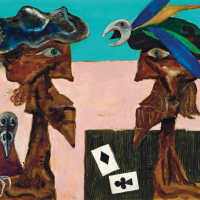75. ALBERT TUCKER

Albert Tucker is renowned for pictorially tough and emotionally charged depictions of Australian life. From his early T.S. Eliot-inspired motifs of the city as a dysfunctional wasteland, and the series Images of Modern Evil and Antipodean Heads, Tucker forged six decades of art under trying conditions. His painting often seemed like a cry from the wilderness and a retreat from the Australian landscape. Influential twentieth-century Melbourne art critic Alan McCulloch reflected upon their lifetime of friendship and support. McCulloch witnessed the development of Tuckers art from beginning to end. He astutely observed of Tucker, If Drysdale supplied the classicism, Boyd, and Nolan the primitivism to the Antipodean movement [then] Albert Tucker supplies the savagery and cutting edge.1
Albert Tucker returned to Australia in 1960 after thirteen years spent abroad. The three years he lived in New York from 1957-60 had brought critical success and financial reward. One of Tuckers major paintings, Lunar Landscape 1957 was purchased by the Museum of Modern Art, New York followed by a second painting in 1960 and one acquired by the Guggenheim Museum in the same period. Tuckers return to Australia also coincided with a successful London exhibition of his Explorer series and the opening of a national touring survey of his work that was organised by his friend and patron, John Reed.
Gamblers and Parrots 1960 from the National Gallery of Australia is indicative of the paintings that Tucker produced once he arrived back in Australia. It is a potent expression of Tuckers new-found confidence as an artist and his focus on male figures placed in recognisably Australian landscapes and settings. Tucker reformulates the infamous face-as-landscape cratered Antipodean Head from 1958-59 into two rough and ready men. The two males are undisputedly Australian with their gaunt features, angular profiles, tilted slouch hats and the ubiquitous screeching of nearby parrots. Tucker recounted in 1965 that his aim was to reveal to Australians the forms and shapes of their own country: The Australian images started forcing themselves on me, he remarked, and I couldnt do anything about it. I began my first series of Australiana the land images. Later the human factor became involved, and thats when I started my explorer figure. Now the land and the figure merge easily into one genuine Australian image.2
Intruder and Parrots 1965 is another important early variation on the man in an inhospitable landscape theme. In this painting, a weathered, stoic figure is juxtaposed against a browned, desolate background. The barrenness of the resulting scene is conveyed through thin washes of polyvinyl acetate that the artist has laid down in broad, spare strokes. The parrot, with a pincer-like beak, appears again. This time its role is to reinforce the title of the work, which pits man against nature rather than in tune with the land.
Our current work, The Gamblers 1973, represents an important addition to Tuckers lexicon of man in the bush an extension of the two earlier pictures. The subject of two gamblers facing-off and the familiar setting, reversed from a 1/3 to 2/3 configuration, and the use of brown/pinks and blue, is an adaptation of Gamblers and Parrots 1960. The shallow, claustrophobic pictorial space of the earlier work remains. It is as if the confronting demeanour of the two men extend beyond the two-dimensional picture plane. The intense drama and seriousness of their confrontation emerges despite the unsettling blank stares.
The Gamblers also looks back to Intruder and Parrots 1965. Tucker reuses the highly recognisable motif of a head and torso shown in profile, along with the depiction of an impossibly stretched, cylindrical neck. Both elements contribute to the idea of man becoming part of the country. The parrot perched on the mans shoulder to the left of both paintings adds an additional element of intrigue. The parrot gazes outwards to directly engage with the viewer. Such positioning suggests a symbolic or allegorical role. Is Tucker intimating that the bird is synonymous with the Australian bush and has finally accepted the new arrival? Or is the bird poised ready to tear the man apart with its carrion-inducing talons? The relationship between man and bird is a dual-edged sword.
Tucker insinuates that the more one explores - attempts to control - the harsh Australian landscape, one rarely, if ever, gains a feeling of being at home. Albert Tuckers vision of Australias settler culture, and its uneasy alliance and dominion over the Australian bush, is speculative at the best of times.
Footnotes:
1. McCulloch A., letter to Brian Kennedy, 15 January 1986, in the Alan McCulloch Papers, La Trobe Australian Manuscripts Collection, State Library of Victoria, Melbourne
2. Featured Artists: Albert Tucker, Art Gallery of New South Wales, Sydney (accessed September 2022): https://www.artgallery.nsw.gov.au/collection/artists/tucker-albert/
Rodney James
Rodney James is an independent art consultant who specialises in valuations, collection management, exhibitions, research and writing, and strategic planning for art galleries and museums.